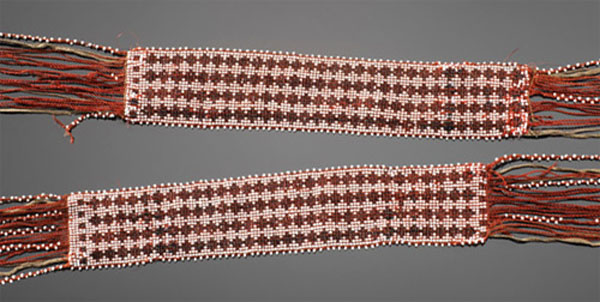 |
 |
Photographs (left to right): Arches National Park, Utah, Zion National Park, Utah; Rochester Lower Gorge, Rochester, New York
Wampum Belt Archive
Glass Beaded Garter

Seminole ca. 1835
Dr. George Jackson Fisher Collection (NMAI 22/9751)

Reproduction by Gary Bertelsen
Original Size: |
Length: 84 cm by 7 cm. 33.0 x 2.8 inches |
Reproduction: |
|
Beads: |
|
Materials: |
Wool Yarn, glass beads. |
Description:
These leg garters likely belonged to the Seminole leader Osceola. Born in 1804 to Polly Coppinger, a part Muscogee Creek woman, Osceola was the most famous of several Seminole leaders who rose to prominence during the Second Seminole War, from 1835 to 1842. Osceola, whose name means Black Drink Singer, was also strong in medicine and was known for his ability to consume the black drink made from yaupon holly. Osceola’s great strength as a leader in war was his ability to plan and supervise multiple attacks. He was involved in more than a dozen battles and skirmishes and led Seminole warriors and their Creek and African-American allies against the U.S. Army and Florida militia and volunteers from 1835 until 1837, when illness led him to surrender. Osceola enjoyed the stature and recognition that he had earned. George Catlin produced two paintings of Osceola. In each of them the war leader wears clothes of Seminole tradition. These finger-woven wool garters, which have beads woven into the pattern, are very similar to the garters Osceola wore in Catlin’s full-length portrait, painted in 1838, shortly before the Seminole leader’s death while he was imprisoned at Fort Moultrie, South Carolina. The image became widely known through a lithograph published by Catlin. Donald L. Fixico (Shawnee/Sac & Fox/Muscogee Creek/Seminole
Reference:
National Museum of American Indian. Infinity of Nations Magazine.
 |
 |
 |
 |
 |
 |
 |
 |
|---|